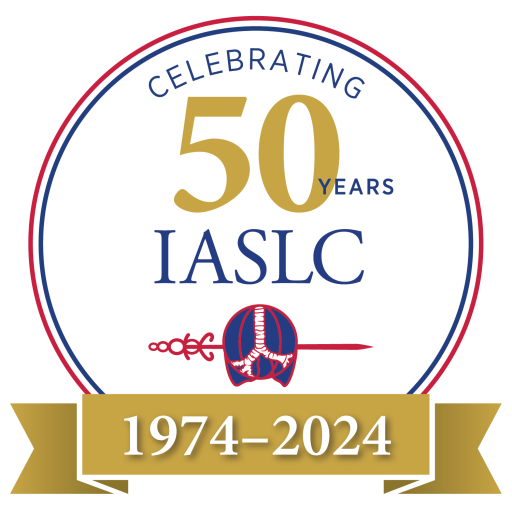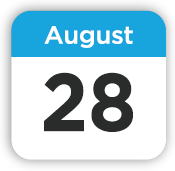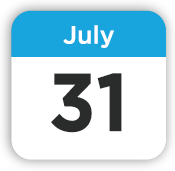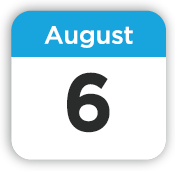
WCLC 2024
Presenter Resources
On this page:
Presenter Resources
Important dates:

July 12, 2024 (23:59 PDT)
Presenting Author Registration Deadline

August 28, 2024
Order Deadline for Onsite Poster Printing

July 12, 2024 (23:59 PDT)
Presenting Author or Title Change Deadline

August 28, 2024 (23:59 PDT)
E-Poster Submission Deadline

July 31, 2024
Launch of Slide, Poster and Video Submission Portal

August 28, 2024
Poster Video Recording Submission Deadline

August 6, 2024
Oral and Mini Oral Slide Submission Deadline
Templates & Documents:
General Presentation Guidelines:
- Time and Slide Limit: 10 minutes presentation with max. 10 slides (excluding title and author slides)
- No Disclosure Slide Required
- Slide Submission Deadline: August 6, 2024 (Portal Opens July 31, 2024)
- Presentation Format: 16:9
- Use Presentation Slide Template
- Review Best Practices for Oral Presentations
- Room Arrival: Please be present 10 minutes before the session begins
- Time and Slide Limit: 5 minutes presentation with max. 5 slides (excluding title and author slides)
- No Disclosure Slide Required
- Slide Submission Deadline: August 6, 2024 (Portal Opens July 31, 2024)
- Presentation Format: 16:9
- Use Presentation Slide Template
- Room Arrival: Please be present 10 minutes before the session begins
As a Poster Presenter you are asked to prepare/submit three documents:
- Printed Poster
- Electronic Version of Your Poster
- Recording of Your Poster Presentation (Optional, max. 5 minutes)
Printed Poster
- Poster Size: maximum 8 feet (width) x 4 feet (height) – landscape format
- Use Poster Template
- Review Best Practices for Creating an Engaging Poster
- Poster Onsite Printing Services Available
- Pins will be Provided to Secure the Poster to the Poster Board
- Mandatory Attendance during Assigned Poster Session (P1, P2, P3 or P4)
| Poster Set Up Time | Poster Take Down Time | MANDATORY Poster Presenter Stand By Time = Poster Viewing Session | |
| Poster Session P1 | Sun, Sep 8 07:00 – 08:30 | Sun, Sep 8 19:45 – 20:15 | Sun, Sep 8 – 12:00 – 14:00 |
| Poster Session P2 | Sun, Sep 8 – 18:15 – 19:45 | ||
| Poster Session P3 | Mon, Sep 9 07:00 – 08:30 | Mon, Sep 9 20:00 – 20:30 | Mon, Sep 9 – 12:00 – 14:00 |
| Poster Session P4 | Mon, Sep 9 – 18:30 – 20:00 |
Electronic Version of Your Poster
- Presentation Format: 16:9 PPT
- Multiple slides are allowed
- File Format: PDF
- Review Best Practices for Creating an Engaging Poster
- Slide Submission Deadline: August 28, 2024 (Portal Opens July 31, 2024)
Recording of Your Poster Presentation (Optional, max. 5 minutes)
- File Format: MP4 (preferred) or MOV
- Maximum 5 Minutes
- Aspect Ratio: 16:9
- Recording Submission Deadline: August 28, 2024 (Portal Opens July 31, 2024)
As an E-Poster Presenter you are asked to prepare/submit two documents:
- Electronic Version of Your Poster
- Recording of Your Poster Presentation (Optional, max. 5 minutes)
Electronic Version of Your Poster
- Presentation Format: 16:9 PPT
- Multiple slides allowed
- File Format: PDF
- Review Best Practices for Creating an Engaging Poster
- Slide Submission Deadline: August 28, 2024 (Portal Opens July 31, 2024)
Recording of Your Poster Presentation (Optional, max. 5 minutes)
- File Format: MP4 (preferred) or MOV
- Maximum 5 Minutes
- Aspect Ratio: 16:9
- Recording Submission Deadline: August 28, 2024 (Portal Opens July 31, 2024)
- Time and Slide Limit: Presentation Time as per Invite (max. 1 Slide per Minute)
- No Disclosure Slide Required
- Presentation Format: 16:9
- Use Presentation Slide Template
- Review Best Practices for Oral Presentations
- Room Arrival: Please be present 10 minutes before the session begins
- Content Guidelines: Balanced, evidence-based, and unbiased
Important Note: For Discussants, your role is to provide a brief summary of the work that has been presented, commenting on the strengths and weaknesses and placing it in the context of other research/knowledge in the relevant area.
- Time and Slide Limit: Presentation Time as per Invite (max. 1 Slide per Minute)
- No Disclosure Slide Required
- Presentation Format: 16:9
- Use Presentation Slide Template
- Review Best Practices for Oral Presentations
- Room Arrival: Please be present 10 minutes before the session begins
- Content Guidelines: Balanced, evidence-based, and unbiased
Poster Printing Services
FedEx SDCC
[email protected], +1 619-525-5450
Poster Printing Rates (Other Sizes Subject to Availability)
- 63 x 42 - USD 147.25
- 72 x 36 – USD 139.50
- 84 x 42 – USD 193.75
Artwork Specifications
- Hi-resolution (300dpi or greater)
- PDF File only (flattens layered graphics)
Order Deadline: August 28, 2024 (Orders after the deadline are subject to change and premium fees – please email FedEx directly at: [email protected] or call +1 619-525-5450)
Accepted Payment Methods: All major CC, debit or cash
Best Presentation Practices
Presenting Authors Must Comply With The Following Guidelines:
- Do not include a disclosure slide (a disclosure summary will be provided to all delegates).
- The presenting author must control all content. Commercial interests may not influence scientific content by requiring the use of company slide decks or other materials. Scientific data generated by industry sponsored research is permissible.
- The content of educational activities must be well-balanced, evidence based and unbiased. Generic names should be used to the extent possible.
- Slides, abstracts, and handouts cannot contain advertising, QR codes, corporate logos, trade names, or product-group messages of an ACCME-defined ineligible company.
- Acknowledgments at the close of presentations should be limited to non-commercial entities, e.g., education or research institutions, foundations, patients, other faculty, or researchers. If it is required to acknowledge an ACCME-defined ineligible company only the name may be mentioned. The commercial logo cannot be used.
PowerPoint Best Practices:
- Technical:
- Your presentation must be prepared in PowerPoint2000 or any later PowerPoint Version (MS Windows).
- Set the slide size of the page to “On-screen show” and landscape orientation in the page set-up section. (Portrait orientation will not be displayed properly).
- Formatting:
- Use high-contrast lettering, and not too much text per page (max. 5-10 lines or 15-20 words).
- Font sizes should be no smaller than size 14 or 16 for maximum visibility.
- Make sure you use high-contrast colors for the best definition of your text. Please be aware that red letters or lines are usually not visible.
- Avoid special characters: To avoid any compatibility problems, please do not use special characters (i.e. “, Ö, Ø, ñ, ?, ®, ý, }, { etc) to name your presentation files.
- Content and Organization:
- Do not read the slides word for word. Visual material provides cues and images to support your verbal presentation.
- Make sure your presentation has a clear flow from introduction to conclusion. Identify key points and why they are important.
- Include take-home points. Consider which 2-3 points you want the audience to remember after your presentation.
- Less is more! Include relevant information on your slides, supplemented and explained by your verbal presentation.

- Poster Template and Poster Size
- Use the WCLC 2024 poster template, which is set up for the full use of the maximum poster size 4” (h) x 8” (w) if printed at 200%.
- Maximum Poster Size: 4” (h) x 8” (w) (landscape) – the poster can be smaller but not bigger.
- Clarity of Message
- Determine the core message you want to convey. A poster should focus on a few key points, making the research easy to understand at a glance.
- Content
- Title + Poster Number: Display title and poster number prominently at the top, matching the final program. It should be short, compelling, and descriptive. Make sure it grabs the attention of the audience and clearly indicates the topic of the research.
- Author Disclosure: Not needed on the poster, as disclosure summaries are made available by the Conference.
- Commercial Bias: Avoid commercial logos and names, except for approved entities.
- Authors and Affiliations:
- Authors: List the names of all contributors to the research. Typically, the presenting author’s name is underlined or highlighted. Indicate the corresponding author (if applicable) with an asterisk and provide an email address for further inquiries.
- Affiliations: For each author, include the department, institution, city, and country. If authors have different affiliations, use superscript numbers or symbols next to each author’s name to match them with the correct institutions.
- Abstract: Not necessary as the abstracts are available online.
- Introduction: Briefly introduce the scientific question or problem and the purpose of the study.
- Methods: Briefly describe how the research was conducted. Use diagrams or flowcharts if they can simplify complex processes.
- Results: Present the most important findings with graphs, charts, and images. Make sure each figure has a caption explaining what it shows.
- Conclusion: Summarize the main findings and their implications. Highlight any future research directions.
- References: List the most critical references. Use QR codes for saving space and linking to more extensive lists or related works.
- Acknowledgments: Recognize any support or contributions from others.
- Design for Clarity and Impact
- Layout: Use a clear, logical layout that guides the viewer through your poster. Columns can be effective.
- Visuals: Use high-resolution and quality images, charts, and graphs to illustrate your points. Visuals can help reduce the amount of text but can’t replace it entirely.
- Text: Keep text brief and to the point. Use bullet points and avoid large blocks of text. The font should be large enough to be read from a distance (at least 30 – 36 -point font for text and 60 – 85-point font for headings).
- Color Scheme: Use color to enhance, not overwhelm.
- Make it Interactive
- Include elements like QR codes linking to research papers, datasets, or additional information online.
- Be ready to engage with viewers through a short presentation or Q&A.
- Practice the Presentation
- Prepare a brief overview of the poster to engage interested attendees. Practice explaining the research clearly and concisely.
- Feedback Before Finalizing
- Get feedback from peers or mentors on the poster before finalizing it. This can provide insights into how well the message is coming across and what improvements can be made.
- Technical Tips
- Follow the conference’s guidelines regarding size and orientation.
- Use software like PowerPoint for designing your poster. Highly encouraged to use the conference template.
- Ensure all graphs and images are high resolution to avoid pixelation when printed.
- Ensure all names are spelled correctly and titles (e.g., PhD, MD) are appropriately used.
- Printing and Presentation
- Print the poster on quality material. Consider a matte finish to reduce glare. See conference guidelines for assistance on printing on site.
- On the day of presentation, bring handouts or business cards to distribute if appropriate.
Please see an example powerpoint template of tips. Powerpoint Example
Poster Printing Guidelines
Poster Presenters are asked to prepare and print their poster(s) for display at the Conference. It is important to set up your slide to a size that is proportional to the printed size of the poster. In PowerPoint, go to Page Setup and select Custom. Fill in the proper width and height.
- The maximum poster size is: 8’ (wide) x 4’ (high) – landscape format.
- One slide only please! Create your poster from a single PowerPoint slide.
- Fonts – Choose two fonts at most, nothing cursive. Stick to sans-serif fonts for legibility: Arial and Helvetica are recommended. If you wish to use a serif font, we recommend Times New Roman (Windows) or Times (Macintosh).
- Excel Charts – You can paste Excel charts into PowerPoint: from Excel, select your chart and Copy, then in PowerPoint, Paste the chart where you want it to appear. For detailed instructions see Microsoft Office Support.
- Word Text – Insert a text box into your PowerPoint slides, copy the text from your Word document and paste it into the textbox in your slide.
- Image Files – To add image file, select “Insert”>”Picture”. Images should be good quality and appear clear and sharp on your screen. Since they will be enlarged for printing, we recommend that images are set to a resolution of 300 dpi.
- Backgrounds – For legibility and viewing ease, we suggest that you keep your backgrounds simple and avoid using dark colors.
- Poster Number – Please note that your poster number will be different than your ABSTRACT ID number. Your poster number will be communicated to you closer to the conference. This number will be displayed on your poster board, please affix your poster under your number displayed.
- Double-sided cohesive tapes will be provided in the Exhibit Hall to set-up posters.
IASLC is encouraging all poster presenters to submit a 5 minute video of their Poster or E-Poster. The video is in addition to the printed poster and the PPT slide (electronic version) of your poster.
- Technical Requirements:
- Resolution: Minimum 1080p
- Aspect Ratio: 16:9
- File Format: MP4 (preferably) or MOV
- Maximum Duration: 5 minutes
- Clear audio quality (use external microphone if possible)
- Content:
- Start with a brief introduction of yourself and the topic
- Clearly present the introduction, methods, results (optional for Clinical Trials), and conclusions (optional for Clinical Trials)
- Use simple and concise language
- Include visuals (graphs, charts) to illustrate key points
- Presentation Style:
- Maintain eye contact with the camera
- Speak clearly and at a moderate pace
- Use natural lighting and a neutral background
- Dress professionally and avoid wearing colors that blend into the background
- Record in a quiet place
- Editing:
- Use basic transitions for smooth flow
- Add captions for accessibility
- Include a title and closing slide with your contact information and acknowledgments
- No editing will be done by the WCLC2024 organizers. All videos will be posted as are.
- Submission:
- Check the video file for compatibility and quality before submission.
